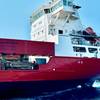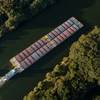Northrop Grumman Corporation has unveiled its testing and risk reduction approach for its Broad Area Maritime Surveillance (BAMS) offer to the U.S. Navy. The
approach is focused on delivering the lowest program execution risk and
a system solution optimized to deliver lowest developmental and life
cycle costs.
BAMS will supply the U.S. Navy with a persistent global
intelligence, surveillance and reconnaissance (ISR) system to protect
the fleet and provide a capability to detect, track, classify and
identify maritime targets. Northrop Grumman's offer includes an RQ-4N
air vehicle derived from the RQ-4B Global Hawk, uniquely configured for
the maritime domain that will meet all of the threshold and more than
90% of the Navy's objective requirements.
The Northrop Grumman approach, called Head Start, identifies a
rigorous risk assessment focused on system elements, sensor
effectiveness, and demonstrating a ForceNet-compliant communications
system. "Our principal objective with Head Start is to deliver to the
Navy the lowest risk and most cost-effective program," said Carl
Johnson, vice president of the BAMS program for Northrop Grumman. "This
approach creates a significant program schedule margin which ensures an
initial operation capability well ahead of threshold requirements."
A major component of the Head Start effort is a flying test-bed
that features a specially modified Gulfstream II business jet equipped
with the radar sensor that Northrop Grumman is offering as part of its
BAMS system. "The test-bed will be used to perform end-to-end
communication functionality testing using the Advanced Mission
Management System for network, bandwidth and sensor control," said Bill
Beck, BAMS Head Start program manager. "It will be tied to a
company-built prototype of the Mission Control System (MCS), located at
our Hollywood, Md., facility."
The prototype MCS contains off-the-shelf commercial software
and hardware components to provide the warfighter with a
state-of-the-art BAMS control station that can be upgraded as
technology evolves. It is being used to demonstrate the effectiveness
of the proposed services oriented architecture and can receive sensor
data, simulated or from the Gulfstream II testbed, and displays and
exploits that data in the same way as BAMS sensor data will be used.
The MCS communications system is equipped with an unmanned
aircraft pilot workstation to fly a virtual Global Hawk being simulated
on Northrop Grumman's Cyber Warfare Integration Network, a virtual,
real-time combat environment used to customize, implement and analyze
operational scenarios. The workstation uses the same protocol proposed
by Northrop Grumman for the BAMS program.
Subscribe for
Maritime Reporter E-News
Maritime Reporter E-News is the maritime industry's largest circulation and most authoritative ENews Service, delivered to your Email five times per week










